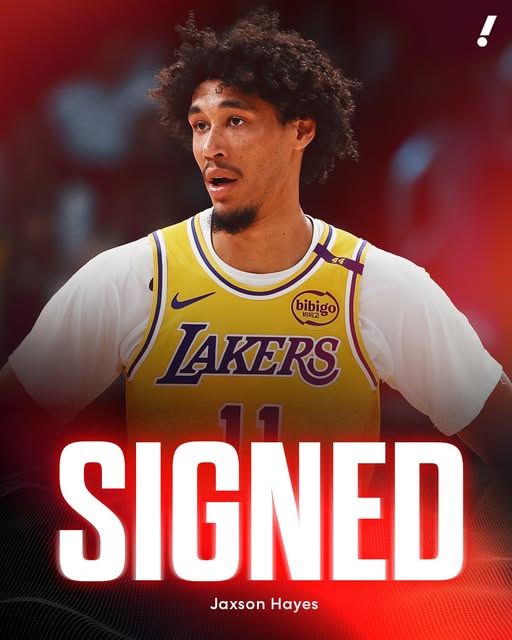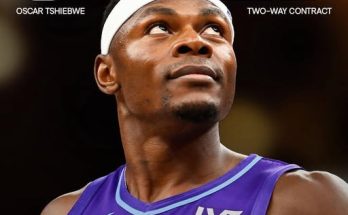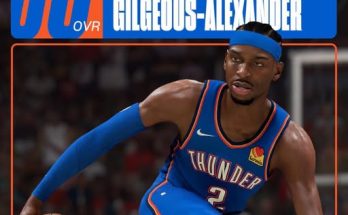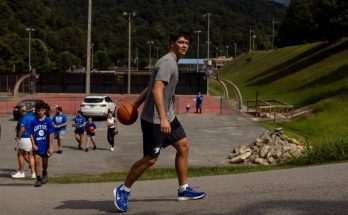The Los Angeles Lakers have officially brought back center Jaxson Hayes on a one-year deal, solidifying their frontcourt depth and doubling down on size in the paint with their second center signing in just two days. The move, though not the flashiest of offseason acquisitions, speaks volumes about the team’s strategic mindset heading into the next NBA season. It’s a move rooted in both necessity and vision, aimed at bolstering rim protection, energy off the bench, and vertical spacing—three things the Lakers have at times lacked in consistency during recent playoff pushes.
Hayes, who joined the Lakers in the 2023–2024 season, returns after a year in which his role was somewhat limited but important. Standing at 6-foot-11 with elite athleticism, Hayes brings a presence that doesn’t always show up in the box score. He averaged modest numbers last season—around 4.3 points and 3.1 rebounds in 11.2 minutes per game—but his ability to alter shots, run the floor, and play above the rim remained evident whenever he was on the court. Now, with another year under his belt in the purple and gold, the 24-year-old center looks poised for a bigger role—especially considering the Lakers’ renewed focus on rim protection and physicality.
The timing of this signing is no coincidence. Just one day before Hayes’ return was announced, the Lakers made headlines by signing former Phoenix Suns big man Deandre Ayton. Ayton’s arrival was viewed as a blockbuster acquisition, signaling the Lakers’ intent to fortify the paint in a Western Conference that features elite bigs like Nikola Jokić, Karl-Anthony Towns, and Domantas Sabonis. The return of Hayes complements that move by adding depth, familiarity with the system, and a different skillset that thrives in short bursts of energy and hustle.
Lakers General Manager Rob Pelinka has made it clear through these moves that the team is embracing a frontcourt-by-committee approach. The return of Hayes offers continuity and a known quantity—a player who understands Darvin Ham’s defensive schemes and who doesn’t demand touches on offense. His game is predicated on effort, verticality, and timing. In a league increasingly emphasizing switchability and floor spacing, Hayes remains an old-school rim-runner—yet that’s exactly what makes his role so essential. He’s not out there to shoot threes or stretch defenses; he’s out there to patrol the paint, clean the glass, and finish lobs with authority.
One major benefit of Hayes’ return is his chemistry with the Lakers’ core players. While his on-court minutes with LeBron James and Anthony Davis were sporadic last season, Hayes showed flashes of being able to thrive in lineups with either superstar. His lob-catching ability pairs well with James’ passing wizardry, while his willingness to do the dirty work complements Davis’ more refined, versatile skill set. And let’s not forget the potential of Hayes alongside the newly acquired Ayton in twin-tower sets, which could wreak havoc defensively and dominate on the boards against smaller lineups.
This signing also signals the Lakers’ understanding of the physical toll an 82-game season (plus playoffs) takes on big men. Anthony Davis has had his share of injuries over the years, and while Ayton is younger, the grind of a full season can wear down any center. Hayes provides the Lakers with insurance. He’s a player who can start in a pinch, bring energy off the bench, or even fill a matchup-specific role against athletic bigs who excel in transition. Versatility in role is a major asset in today’s NBA, and Hayes brings just that.
Moreover, the move is cost-effective. Hayes’ one-year deal is another example of Pelinka’s balancing act: building a competitive roster while maintaining financial flexibility. The Lakers are always looking at the long-term landscape, especially with the possibility of a post-LeBron era not too far off. By securing Hayes on a short-term contract, they’ve left themselves open to future moves, whether that be trades, extensions, or even a larger free agency splash next summer. It’s smart, calculated roster management.
From a fan’s perspective, bringing Hayes back may not move the needle like signing an All-Star, but it’s the kind of move championship teams quietly make to complete their rosters. Every great team needs its role players—the ones who defend without demanding the ball, who run hard in transition, who cheer on teammates from the bench with genuine energy. Hayes has shown he can be that guy. And in the pressure-cooker environment of L.A., character matters. Hayes, by all accounts, is a locker room positive, a player willing to do what’s asked of him, and someone who’s bought into the Lakers’ culture.
His development also remains an intriguing subplot. Drafted eighth overall in 2019 by the New Orleans Pelicans, Hayes entered the league as a raw, freakishly athletic big man with sky-high upside. While he hasn’t yet blossomed into a star, his ceiling hasn’t been capped either. Sometimes bigs take longer to develop, especially those whose games are based more on instinct and timing than refined post moves or jump shots. Under the guidance of the Lakers’ coaching staff and surrounded by veterans who demand excellence, Hayes still has time to sharpen his game. If he can improve his pick-and-roll defense, free-throw shooting, and overall discipline on the court, he could become one of the better backup bigs in the league—or more.
The timing of the deal also speaks to the Lakers’ urgency. With the Western Conference expected to be a battlefield again—Denver, Minnesota, Dallas, Phoenix, and OKC all vying for dominance—the margin for error is razor-thin. Depth wins games in February and March. Depth wins back-to-backs, stretches of 5 games in 7 nights, and double-overtime grinders on the road. By bringing back Hayes, the Lakers are showing they won’t be caught thin in the trenches. They’re locking in the paint, and they’re doing it with purpose.
Another key layer to this deal is Hayes’ fit alongside the Lakers’ younger players, such as Max Christie, Jalen Hood-Schifino, and whoever may emerge from their Summer League roster. Hayes, while still young himself, is entering his sixth NBA season. He’s seen enough to offer guidance but still has the athletic edge to play the same fast, aggressive brand of basketball as the young guns. If the Lakers hope to develop internal talent while remaining competitive, they need bridge players like Hayes—guys who can relate to the youth but also understand the weight of wearing the purple and gold.
As for head coach Darvin Ham, he now has more flexibility with his rotations. Hayes can be deployed situationally, used in small-ball counters, or slotted in for spurts when the Lakers want to push the pace and play above the rim. Ham has emphasized a defense-first identity since taking the reins, and Hayes fits that mold. He’s not a shot creator, but he’s a shot eraser. And sometimes, that’s even more valuable in the playoffs when possessions become scarce and every bucket is contested.
Ultimately, the return of Jaxson Hayes might not make SportsCenter headlines the way a LeBron tomahawk dunk or an Ayton 20–20 game might. But that doesn’t mean it isn’t significant. Championship rosters are forged with stars, yes—but also with specialists, grinders, and unselfish athletes willing to embrace their lane and play it to perfection. Hayes is one of those players. And with the Lakers eyeing another deep postseason run, having someone like him in the mix could make all the difference when it counts most.
The Lakers’ front office has made its stance clear: they’re building a team that can go the distance. The return of Jaxson Hayes is another brick in that foundation. Not glamorous, but sturdy. Not loud, but vital. With Hayes back in L.A., the Lakers’ paint is locked down—and their championship ambitions remain very much alive.



